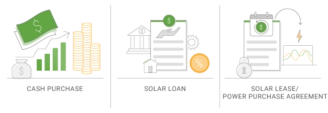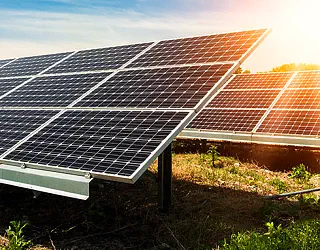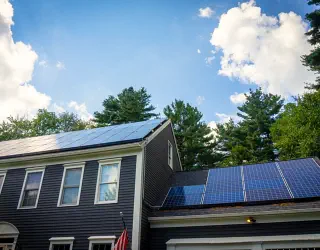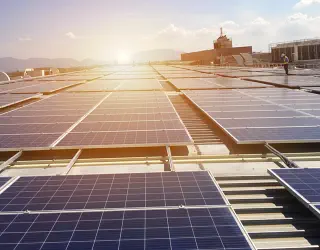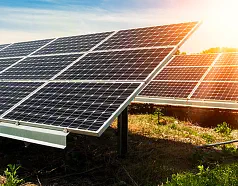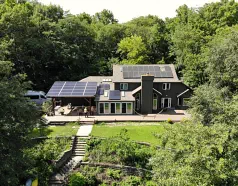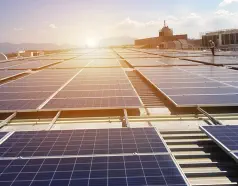Business Hours
Monday - Friday 9 AM – 7 PM
Saturday 10 AM - 9 PM
Sunday Closed
(248) 387-9870
Helping Providing Solar Power throughout the USA!



© 2021 Prometheus Power Group, Inc. All Rights Reserved.
SOLAR FINANCING
Solar Financing
There’s a reason why 2.5 million homeowners–and counting–have already installed solar in the US: it’s a great investment! Solar panel systems
last for 25 years or more, offsetting most or all of your electricity bill every month. Those monthly savings add up quickly: if you spend $150 per
month on electricity today, you’ll spend over $65,000 on electricity in the next 25 years. By investing in solar, you can avoid most or all of that
future spending on electricity.
But solar isn’t free - to get these levels of savings, you have to first pay for your solar panel system, with a typical solar panel system costs around
$15,000 - $25,000. Thankfully, there are a number of different ways to pay for your solar panel system, each with their own pros and cons.
Solar financing options
There are three primary ways to pay for solar: with a cash purchase, with a solar loan, or with a solar lease/power purchase agreement.
solar financing options
Cash purchase
There are two ways to pay for a solar panel system that you own outright: an upfront, cash payment and a solar loan. A cash purchase of a solar
panel system is the best way to maximize your savings from solar. Think of it this way: if your solar panel system is designed to produce 100% of
your electricity needs, then if you purchase your solar energy system upfront you’ve just paid for 25 years’ worth of electricity. Pretty cool! You’re
insulated from any future electricity rate increases and you’ll receive all of the financial incentives and rebates associated with going solar. Overall,
this means you’re likely to see a better return on your investment from solar than if you were to put that money into the market.
At the same time, the one clear drawback of a cash purchase is that solar isn’t cheap. If you want to purchase your system in cash, you’ll need to
have enough capital on hand to pay for the system, which can set you back $20,000 to $30,000.
Solar loans
The second main way to own a solar panel system is with a solar loan. Solar loans are a wonderful financing option because they allow you to go
solar and own the system with no money down, and often at a lower cost than what you pay for electricity at the moment. In other words, solar
loans make it so that if you can afford your monthly electricity bill, you can afford to put solar on your roof. Not too shabby!
Solar loans may seem similar to a solar lease or PPA, but there’s one key difference which has two major implications: with a solar loan, you own
the system, whereas with a solar lease/PPA, a third party owns the system. This means that with a solar loan, you’re now eligible to receive any
rebates and incentives for the solar panel system, but you’ll also be responsible for any future maintenance.
Solar leases and PPAs
Though they’ve declined in popularity in recent years, solar leases and power purchase agreements (PPAs) played a huge role in the growth of the
solar industry in its infancy. Solar leases and PPAs work very similarly, which is why they’re often lumped together: they are both a method of third
party ownership (TPO), where that third party owner installs solar panels at your property and then sells you the electricity produced by the solar
panels at a predetermined rate. There are subtle differences in how leases and PPAs work, but they’re similar enough that it’s easier to keep them
together.
With a lease/PPA, you’ll typically lock in a set rate for electricity for the next 25 years, about 10 to 30 percent below the rate you currently pay for
electricity. Historically, leases and PPAs built in an escalator to your payments, meaning that each year you would pay more for your solar than you
did the year prior, but recently, the trend has been for leases/PPAs locked in at a specific rate for the entire contract period. What’s more, with a
lease/PPA, the third party owner is responsible for monitoring the system and any maintenance on it, meaning there’s always somebody looking
out for the well-being of your solar panel system.
Because you don’t own the solar panel system in a lease/PPA set up, you won’t be eligible to receive any of the financial incentives and rebates
associated with solar; rather, the company that owns the system will be. Additionally, while homes with solar sell for 3-4 percent more than similar
homes without solar, that’s not always the case with a lease/PPA, since you as the owner of your home aren’t technically the owner of the solar.
Note: third-party ownership isn’t available in every state. Here’s DSIRE’s map of states that allow for solar leases and PPAs.
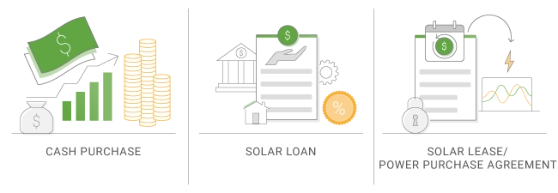
Business Hours
Monday - Friday 9 AM – 7 PM
Saturday 10 AM - 9 PM
Sunday Closed
(248) 387-9870
Helping Providing Solar Power throughout the USA!



© 2021 Prometheus Power Group, Inc. All Rights Reserved.






SOLAR FINANCING
Solar Financing
There’s a reason why 2.5 million homeowners–and
counting–have already installed solar in the US: it’s a
great investment! Solar panel systems last for 25
years or more, offsetting most or all of your electricity
bill every month. Those monthly savings add up
quickly: if you spend $150 per month on electricity
today, you’ll spend over $65,000 on electricity in the
next 25 years. By investing in solar, you can avoid
most or all of that future spending on electricity.
But solar isn’t free - to get these levels of savings, you
have to first pay for your solar panel system, with a
typical solar panel system costs around $15,000 -
$25,000. Thankfully, there are a number of different
ways to pay for your solar panel system, each with
their own pros and cons.
Solar financing options
There are three primary ways to pay for solar: with a
cash purchase, with a solar loan, or with a solar
lease/power purchase agreement.
solar financing options
Cash purchase
There are two ways to pay for a solar panel system
that you own outright: an upfront, cash payment and a
solar loan. A cash purchase of a solar panel system is
the best way to maximize your savings from solar.
Think of it this way: if your solar panel system is
designed to produce 100% of your electricity needs,
then if you purchase your solar energy system upfront
you’ve just paid for 25 years’ worth of electricity.
Pretty cool! You’re insulated from any future electricity
rate increases and you’ll receive all of the financial
incentives and rebates associated with going solar.
Overall, this means you’re likely to see a better return
on your investment from solar than if you were to put
that money into the market.
At the same time, the one clear drawback of a cash
purchase is that solar isn’t cheap. If you want to
purchase your system in cash, you’ll need to have
enough capital on hand to pay for the system, which
can set you back $20,000 to $30,000.
Solar loans
The second main way to own a solar panel system is
with a solar loan. Solar loans are a wonderful financing
option because they allow you to go solar and own the
system with no money down, and often at a lower cost
than what you pay for electricity at the moment. In
other words, solar loans make it so that if you can
afford your monthly electricity bill, you can afford to
put solar on your roof. Not too shabby!
Solar loans may seem similar to a solar lease or PPA,
but there’s one key difference which has two major
implications: with a solar loan, you own the system,
whereas with a solar lease/PPA, a third party owns the
system. This means that with a solar loan, you’re now
eligible to receive any rebates and incentives for the
solar panel system, but you’ll also be responsible for
any future maintenance.
Solar leases and PPAs
Though they’ve declined in popularity in recent years,
solar leases and power purchase agreements (PPAs)
played a huge role in the growth of the solar industry
in its infancy. Solar leases and PPAs work very
similarly, which is why they’re often lumped together:
they are both a method of third party ownership
(TPO), where that third party owner installs solar
panels at your property and then sells you the
electricity produced by the solar panels at a
predetermined rate. There are subtle differences in
how leases and PPAs work, but they’re similar enough
that it’s easier to keep them together.
With a lease/PPA, you’ll typically lock in a set rate for
electricity for the next 25 years, about 10 to 30
percent below the rate you currently pay for electricity.
Historically, leases and PPAs built in an escalator to
your payments, meaning that each year you would pay
more for your solar than you did the year prior, but
recently, the trend has been for leases/PPAs locked in
at a specific rate for the entire contract period. What’s
more, with a lease/PPA, the third party owner is
responsible for monitoring the system and any
maintenance on it, meaning there’s always somebody
looking out for the well-being of your solar panel
system.
Because you don’t own the solar panel system in a
lease/PPA set up, you won’t be eligible to receive any
of the financial incentives and rebates associated with
solar; rather, the company that owns the system will
be. Additionally, while homes with solar sell for 3-4
percent more than similar homes without solar, that’s
not always the case with a lease/PPA, since you as the
owner of your home aren’t technically the owner of
the solar.
Note: third-party ownership isn’t available in every
state. Here’s DSIRE’s map of states that allow for
solar leases and PPAs.
